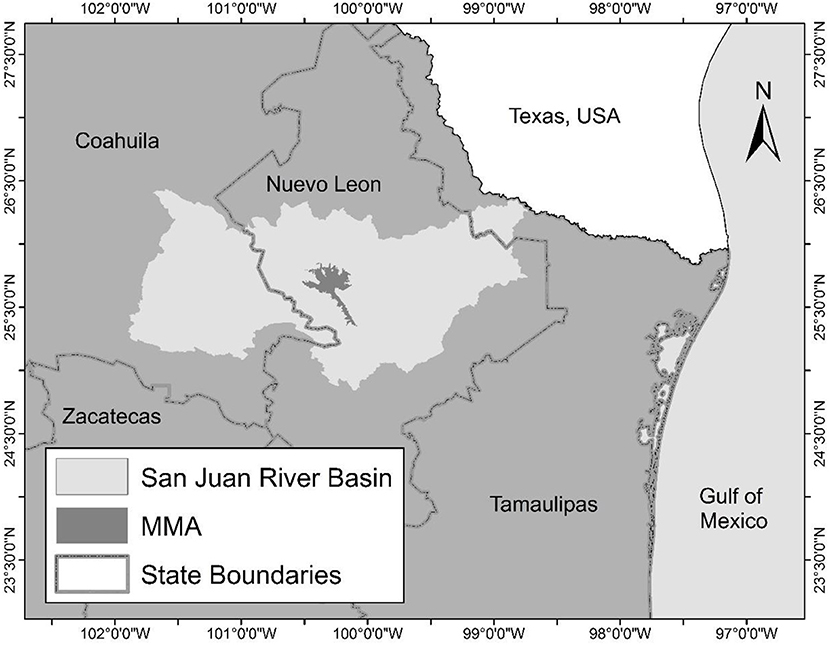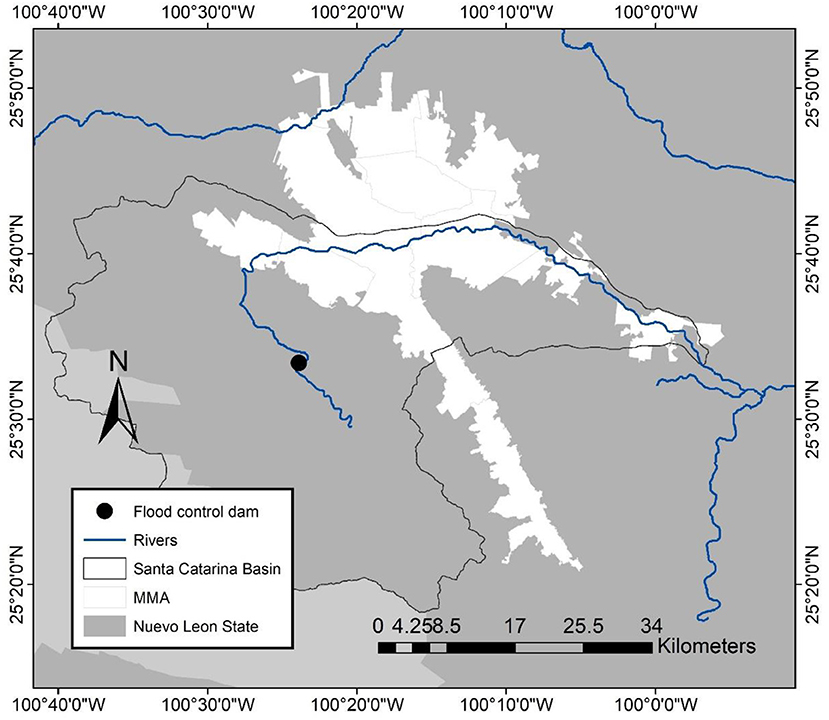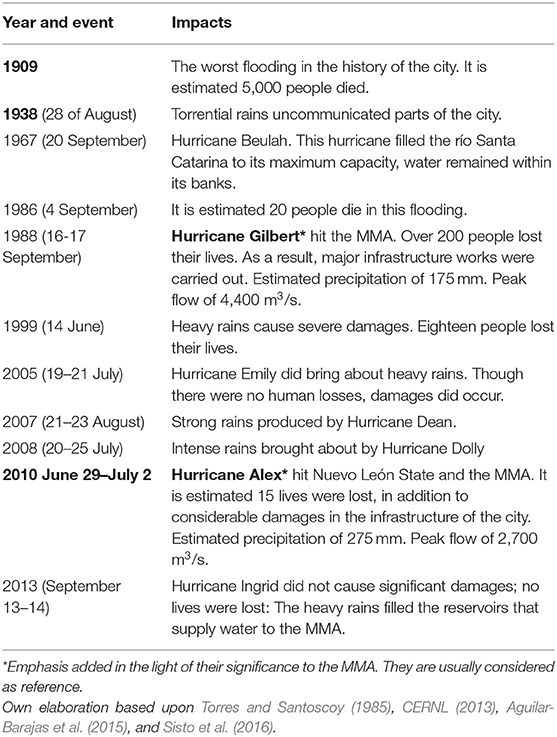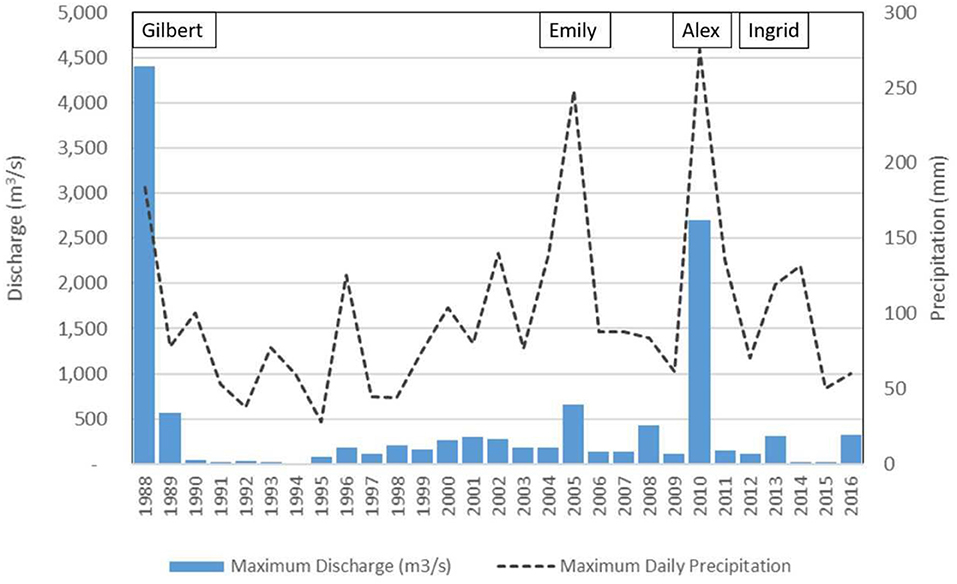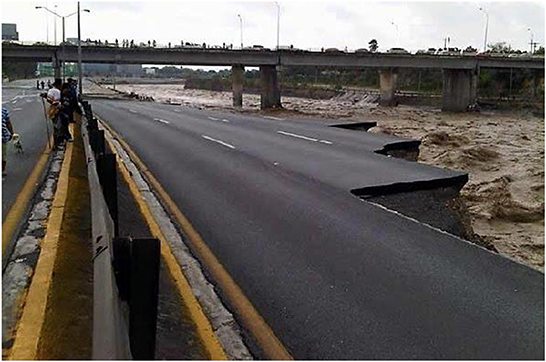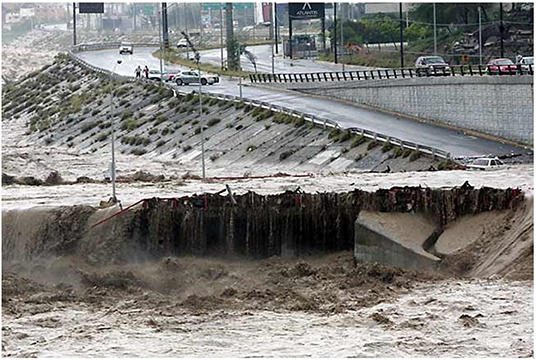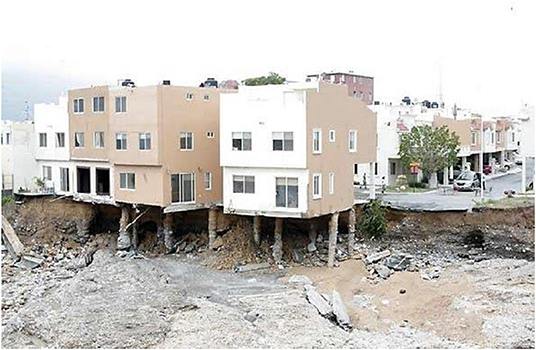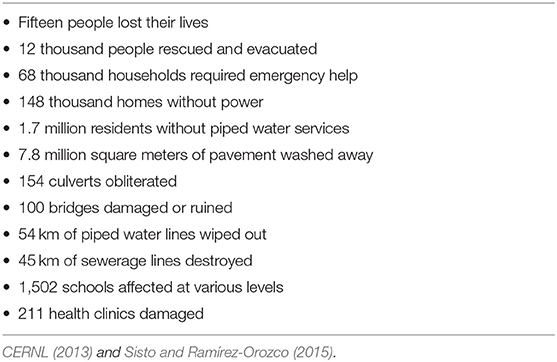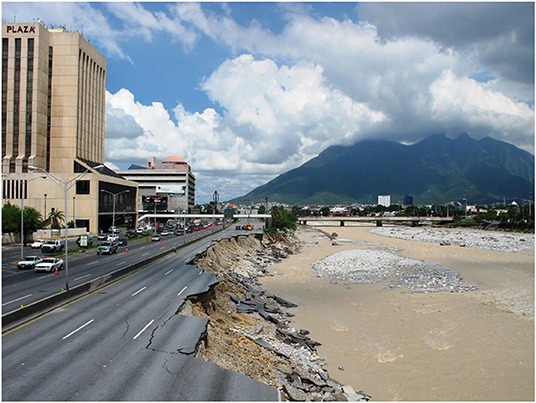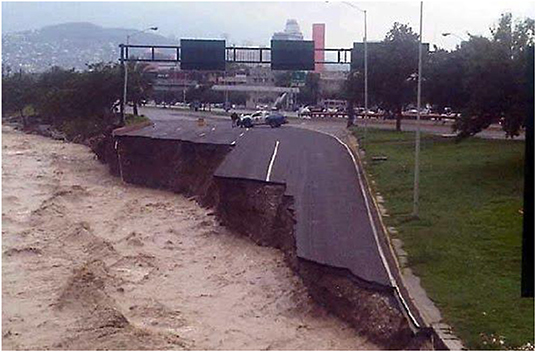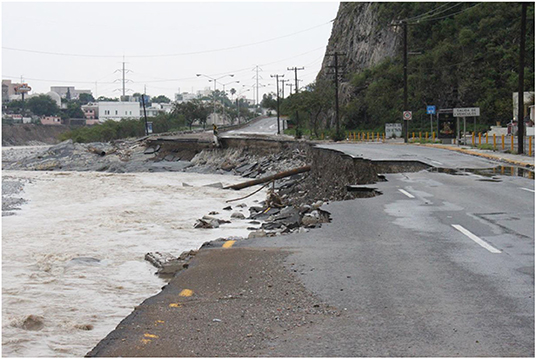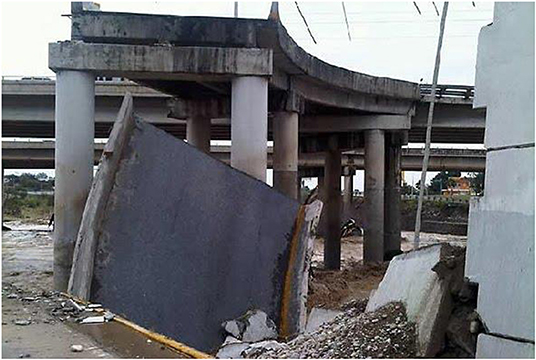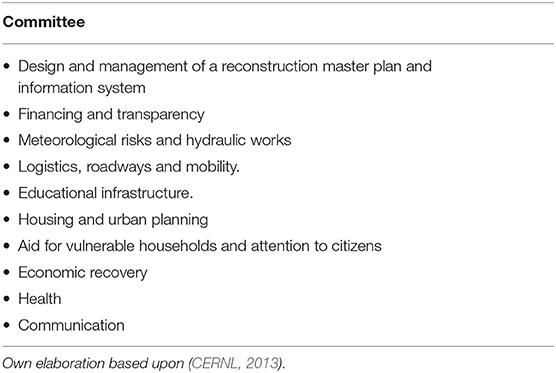- Tecnologico de Monterrey, Monterrey, Mexico
The Monterrey Metropolitan Area (MMA), strategically located in Northeastern Mexico, has a population of over 4.5 million people. The metropolis is the second largest economic center in the country, only after Mexico City, and maintains a key role in the Mexico-US trade corridor. Thus, the issue of urban resilience to extreme weather events is a matter of national security and not only a local concern. In July 2010, Hurricane Alex hit the Monterrey Metropolitan Area (MMA). It is estimated that 15 human lives were lost. The hurricane generated severe damages to the metropolis's infrastructure and economy. In the aftermath of Hurricane Alex, the Nuevo Leon State Reconstruction Council (CERNL, in Spanish) was established, with the participation of government agencies and actors from the local community (universities, non-governmental organizations, and large firms). This paper analyses the role played by the CERNL in the reconstruction of the MMA. In 2013, the CERNL ended its mission. Most basic services and infrastructure were re-established, some of them within a few days and weeks after Alex hit the MMA. The relative good work of the Council, in spite of a fragmented and dysfunctional institutional framework, has to do with a local enabling environment that facilitated its establishment and the carrying out of activities. However, this case study also shows the difficulties associated with the design and implementation of coherent, sound strategies in this governance framework. Furthermore, the metropolis has been losing the policy capabilities built through the Council. This is a very risky current context that could have serious social, economic and environmental damages to Monterrey. The lessons presented in this contribution may be of interest to other cities in Mexico and elsewhere.
Introduction
The theme of building resilience to the occurrence of hurricanes has been gaining a great deal of attention by international organizations, national and local governments, as well as from the academic community. Concerning the former, the World Bank (2013), the United Nations (UN, 2011; UNISDR, 2017), the OECD (2013a), and the World Economic Forum (WEF) (2019) have produced very influential reports that have helped to better understand the complexities of the issues at hand and the urgency for policy intervention. The resilience of urban systems is a particular good example of this interest. As its name implies, the city is seen as part of a wider urban regional system, as has long been argued (Bourne and Simmons, 1978; Friedman, 2002). Central to the notion of resilience is the recovery of, mainly, basic services and infrastructure of regional or national strategic relevance (Meerow et al., 2016; Pant et al., 2018). Bullding back better (Hallegatte et al., 2018) is an expression that encompasses the complex processes behind post-disaster reconstruction, which is not limited to the recovering of the prior provision of services but to improved ones—often through renovated or totally new infrastructure (Miller et al., 2018).
Although it could be improved, Mexico has made good progress toward the management of hazards like flooding. The National Disaster Fund (FONDEN) was established in 1996 to provide financial support to states and municipalities hit by natural disasters (OECD, 2013b). The National Reconstruction Fund (FONAREC) was created in 2010 to aid the reconstruction works as a result of hurricanes Alex and Manuel that affected the country that year (OECD, 2013b). There have also been good advances in the design and implementation of early warning systems (EWS) (Magaña et al., 2014).
In July 2010 Hurricane Alex hit the Monterrey Metropolitan Area. It is estimated that 15 human lives were lost. The hurricane generated severe damages to the metropolis's infrastructure and economy. In the aftermath of hurricane Alex, the Nuevo Leon State Reconstruction Council was established, with the participation of agencies from the three levels of Government (federal, state, and local), and actors from the local community (universities, non-governmental organizations, and large corporations). The establishment and performance of the Council sends a powerful message in the sense that recovery from a major hurricane can be led by the local and business community.
In 2013, the CERNL ended its mission. After spending around US$2.1 billion, most basic services and infrastructure were re-established, some of them within a few days and weeks after Alex hit the MMA. The relative good work of the Council, in spite of a fragmented and dysfunctional institutional framework that involves multiple jurisdictions working at the metropolitan scale (federal, state, and municipal), had to do with a local enabling environment that facilitated its establishment and the carrying out of its activities; the participation of universities and the business community were of great importance, in the light of their credibility built over decades.
Given the economic relevance of the MMA to Mexico, the attention on its vulnerability to flash floods should be a question of national interest and not only a local or regional concern. From a national perspective, however, and notwithstanding the progress that has certainly been achieved, there is a long way to go toward an integrated comprehensive management model for hazards like flooding. Schmidt and Hatch Kuri (2012) argue that the official discourse in regard to water must change to place the management of the resource as strategic and of national security. This requirement goes against a fragmented, dysfunctional and reactive—rather than preventive governance. In its 2011 Report of the Global Evaluation of Disaster Risk Reduction, prepared for the United Nations, Mexico recognized the slow progress regarding the prevention and mitigation of hydro meteorological events, in spite of their strong incidence and severe impacts. The Report estimated that the ratio of reactive to preventive expenditures was 33 to 1 (UN, 2011).
It is in this context that the work of the CERNL is remarkable, even considering its shortcomings and limitations. This paper addresses four major and interrelated questions: (1) What were the major impacts of Hurricane Alex; (2) what has the Alex event revealed about Monterrey's vulnerability and resilience with respect to the risk of flash floods and the existing framework for flood management? (3) what was the role played by the CERN in the reconstruction of the metropolis? and (4) what were the major lessons of the reconstruction?—more particularly, 9 years after Alex, to what extent has Monterrey reduced its vulnerability and increased its resilience to future flash flood events?
More specifically, and after this brief introduction, this contribution is structured into seven parts. The second part contains a basic methodological outlook. The third presents a brief flooding history of the MMA, to provide context to Alex. The fourth centers on the phenomenon Alex, its impacts and the existing water governance for flood management. The work of CERNL is discussed in the fifth part. Part six deals with major policy lessons and recommendations. Part seven presents the conclusions.
Methodological Outlook
This section provides a basic methodological outlook of the methodology used to construct this article, which focuses on the impacts of Hurricane Alex in the Monterrey Metropolitan Area and the reconstruction coordinated by the State of Nuevo León Reconstruction Council. This story is a relatively recent one that has not been discussed in an in-depth way. The references in English are limited and those in Spanish are not abundant.
Although it is not claimed that a comprehensive in-depth analysis is done here, this paper certainly presents not only the process of building resilience to weather hazards related to hurricanes—to provide context to the Alex phenomenon—but also a close up to the role played by the CERN in the reconstruction of the metropolis. In order to do this, the paper offers an essential description of this process of resilience building, from a multidimensional approach. This multidimensionality involves geographical, hydrological, economic, and historical issues. There is special interest in showing how knowledge has been added in this process over several decades, particularly since 1988 when hurricane Gilbert hit the MMA. The achievements, limitations, and shortcomings of the reconstruction are presented within this comprehensive framework.
The methodology followed is structured around the four research questions. It was necessary to study academic references, as well as published and unpublished internal government reports. In addition to this literature review this research also benefited from reflective discussions with relevant respondents. The official final report of the CERNL, with which its mission was finished, was of enormous value. Other documents that were consulted are the following: Nuevo Leon State Development Plan (Gobierno Constitucional del Estado de Nuevo León, 2010a); The Risk Atlas of Nuevo Leon (Gobierno Constitucional del Estado de Nuevo León, 2010b); The Final Official Report of the Water Public Utility about Hurricane Alex (SADM, 2010a) and Minutes of SADM about the reconstruction works undertaken by this institution.
There was also the opportunity to have talks with different people with first-hand knowledge of the reconstruction. This proved to be of great value to aid in the understanding of this complex process. Key informants included, among others: current Nuevo Leon state Secretary for Sustainable Development; two former state governors; current and former Director-Generals of SADM (and their top technical and managerial collaborators); former Director of the MMA's Stormwater Management System; current Director of the Monterrey Metropolitan Water Fund and the former Director of the Regional Office of the National Water Commission.
The Monterrey Metropolitan Area and its Flooding History
The City in Context
The Monterrey Metropolitan Area (MMA) is formed by 12 municipalities including Monterrey, the capital of Nuevo León, a dynamic and prosperous state in Northeastern Mexico within the San Juan River Basin (Figure 1). The metropolis concentrates the bulk of the population and economic activities of the state. The MMA is a major metropolis of around 4.5 million people, and one of the three economic axes of Mexico. Large national corporations have their headquarters here. The foreign direct investment that comes to the country goes to the state of Nuevo Leon, its second destination, only after Mexico City. Most of these flows are directed to the MMA. The metropolis has prospered in spite of being in a semi-arid region, with little rain—unless, of course, a hurricane comes. In addition to this limiting geographical, climatic setting, there is also a complex water management framework (OECD, 2013c; Aguilar-Barajas et al., 2015; Torregrosa et al., 2015). The Santa Catarina River, the MMA's principal watercourse, crosses the whole urban area west to east (Figure 2). This river was channeled in the 1950s, with the intention to reduce the adverse impacts of flooding in the city (Torres and Santoscoy, 1985).
Summary of Recent Flooding History in the MMA
The city has always been prone to flash flood hazards. Table 1 presents a brief chronology of these events. The 1909 flooding remains the worst. The toll in human lives is estimated at 5,000 people (Graham, 1911). The heavy rains of 1938 also left a mark. In more recent times, it is Hurricane Gilbert, that constitutes a before and after in the flooding history of the city. The Santa Catarina River broke its banks; infrastructure built on the margins and the river bed were destroyed. The peak flow in the Santa Catarina River was the highest on record (around 4,400 m3/s CONAGUA, 2018 (Figure 3). The number of human losses vary from over 220 to 280 (Chávez Gutiérrez, 1995; Salazar, 2008; CERNL, 2013). Damages to the metropolitan mobility infrastructure were severe (Bitrán, 2001; Benavides and Lozano, 2013; OECD, 2013b). The magnitude of the damages was compounded by irregular settlements along the margins and even on the river bed, showing the deficient enforcement of land use regulation (de León Gómez, 2009), and the limited or almost non-existing warnings. The early warning system (EWS) was yet to come.
Hurricane Gilbert caused all the damages mentioned above, but also paved the way for more resilient preventive measures to face future floods. Civil protection systems were strengthened and flood control infrastructure was constructed. This is in the case of the Rompepico dam, built during the years 2002–2004. This dam was built in the upper part of the Rio Santa Catarina basin, 22 km upstream of the metropolis to regulate flows in the river. Years later an urban storm drainage system was also undertaken (in the period 2002–2009). The Rompepicos dam was first tested, successfully, during the occurrence of Hurricane Emily in July of 2005. The EWS were already in place (Cenapred, 2006). Damages were small and no human lives were lost. This was not going to be the case of Hurricane Alex, which would hit Monterrey 5 years later. In both cases, however, the role of this soft and hard infrastructure was crucial.
As a background to what is the central theme of this paper, it is worth mentioning the establishment of the State Reconstruction Council to deal with the reconstruction after Gilbert (Benavides and Lozano, 2013). This council was formed 2 days after the hurricane hit. In comparison with what was going to be the case of Hurricane Alex, this board was fairly small. It was presided over by the state governor. As in the case of Alex, however, the reconstruction was led by a prominent figure of the private sector. The council had immediate access to a civil contingency fund of then 1,000 million pesos (US $ 440 million), created as a result of the earthquake that hit Mexico City in 1985. This fund was created precisely to attend a contingency derived from a natural disaster. In September 2013 came Hurricane Ingrid; the damages were not very significant. Ingrid did, however, bring much needed water to fill up the reservoirs that supply water to the MMA.
The Impacts of Hurricane Alex (2010) and Water Governance in the MMA
Hurricane Alex and Its Impacts
Alex is considered among the strongest hurricanes that have affected Mexico in the last 50 years. In Nuevo León, this hurricane caused the loss of at least 15 people and considerable economic assets (Sisto and Ramírez-Orozco, 2015). In Nuevo León, and particularly in the MMA, Alex did bring about torrential rains that amounted to up to 446 mm in 24 h and above 800 mm in 48 h. It is estimated that the maximum discharge on the Santa Catarina River was about 2,700 m3/s (Ramírez, 2011). According to CONAGUA (2018), the Santa Catarina River reached its second highest recorded flow (Figure 3). This was the direct result of the flood control dam, built upstream from the city as part of post-Gilbert resilience building efforts in the MMA. Figure 4 exhibits a view of the river during the event. Figures 5–7 illustrate some of the damages in the city.
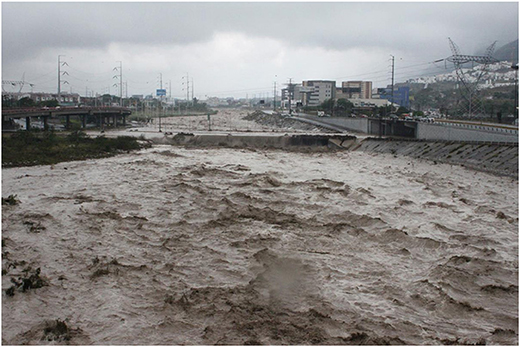
Figure 4. The Santa Catarina River during Hurricane Alex, July 2010. Courtesy from the National Water Commission.
The damages of Alex included urban infrastructure (electrical network, water and drainage, as well as roads and bridges), housing and vehicles (Table 2). The two main arteries of the metropolis—Constitución and Morones Prieto were seriously affected (Figures 8–11). This not only caused severe mobility problems for the MMA, but it also damaged the links of the city with national markets and the US (via Texas). The CERNL estimated the reconstruction works at around MX17 billion pesos (US$ 1.3 billion). Estimates of the OECD suggest a figure of over US$2.1 billion (OECD, 2013b). Since these are the estimates for the reconstruction that took place, it is very likely that the real damages had been higher. Fortunately, the flood control dam plus the storm drainage infrastructure, as well as the EWS were key to reducing the adverse impacts of Alex. This time the city was not taken by surprise.
The Existing Framework for Flood Management in the MMA Before Alex
Hurricane Alex revealed the coexistence of both a resilience base and serious vulnerabilities in respect to flood management in the MMA. Concerning the former, before this event the metropolis already had in place the flood control dam, storm drainage infrastructure, as well as the EWS. There was also a proven financial capacity of prosperous metropolis, as well as a long-standing business and academic involvement in urban policy design. Although Alex revealed some shortcomings, it is also fair to say the metropolis displayed technical capabilities in the recovering process. The case of the metropolitan water utility—and the quick recovery of water and sanitation services—is a good example. It is worth underlying that business leadership and credibility were key in the establishment and performance of the CERNL.
Notwithstanding this context of preparedness, by the time Alex hit there was also a vulnerable metropolis. Metropolitan governance was not functioning well (EGAP, 2010), which was illustrated by the insufficient coordination between and within the three levels of government—federal, state, and local (Aguilar Barajas et al., 2016). The legal framework was either unclear or with superseded responsibilities of these levels. Comprehensive urban planning and risk management were rarely mentioned in the state development plan of the time (Gobierno Constitucional del Estado de Nuevo León, 2010a). Furthermore, it is striking that the draft of the first Risk Atlas (Gobierno Constitucional del Estado de Nuevo León, 2010b) was still under review well after the hurricane had hit the state and the metropolis. Not surprisingly, as it happens in Mexican cities, irregular settlements exposed to flooding were also very common, notwithstanding the fact that the regulatory framework prohibited this practice (Leal Diaz, 2012). Solid waste management was separated from water and sanitation management. The leisure and sporting structures and activities located on the river bed could have contributed to reduce the hydraulic capacity of the river, which was already insufficient to handle the flow. The enforcement of land use planning directives faced strong political opposition.
In summary, the balance of resilience and vulnerability conditions prior to Alex indicate the existence of a local enabling environment that was able to mobilize collective actions and the establishment of the CERNL.
Hurricane Alex and the Nuevo León State Reconstruction Council (CERNL) (2010–2013)
The Council's Structure and Operation
The arrival of Hurricane Alex in July 2010 has been highly significant for the state of Nuevo León and the Monterrey Metropolitan Area, especially due to the way in which reconstruction works were addressed. The same month that hurricane Alex occurred, the state government established the State Council for the Reconstruction of Nuevo León (CERNL), to guide and coordinate all reconstruction works. The Council was formed with representatives from all three levels of government and civil society actors, predominantly from prominent members of the business community and the principals of the major local universities. The operation of the Council was structured into ten committees (Table 3). The coordination of the committees was held by prominent figures of the business community (CEOs of large Mexican corporations based in Monterrey) and the academic world (principals of the major local universities).
Although the overall functioning of the CERNL went relatively well, the operation of the Council was complex and not trouble free. Coordinating this large number of committees was difficult, a situation that was exacerbated by the rotation of those responsible for federal and state agencies due to normal changes in government positions (Torregrosa et al., 2015). Soon after the establishment of the CERNL, between half and two thirds of government officials left their positions. Although these positions were filled by other people, it is likely that these changes had affected the undertaking of works.
For example, in April 2011 the structure of the Council saw changes. In the third planning meeting, which took place on the 11th of this month, it was decided to conclude and/or restructure the works of several committees. Educational Infrastructure, Aid for Vulnerable Households and Attention to Citizens belonged to the first group. The committees of Meteorological Risks and Hydraulic Works, Housing and Urban Planning were integrated into the Citizens Council for Urban Development. By doing this, the very important functions originally assigned to these committees lost relevance. This was also the case for the Committee for Economic Reactivation which was incorporated into the program Nuevo León: A model for Development.
First Tasks and Responses From the Nuevo León State Reconstruction Council
Very early on, the Council understood the seriousness of the problematique behind the reconstruction tasks. In its second working meeting, on the 16th of December, 2010, the CERNL reached the following agreements, which are cited textually below and were taken from the official website of the Council:
• To manage in an efficient and transparent way the resources from FONDEN, and those from FONAREC;
• To seek an ordered urban development pattern;
• To monitor, closely, the commitments, requirements, and necessary supports for the execution of priority reconstruction projects, including, of course, the two major avenues Constitucion—Morones Prieto, which are at the heart of the metropolis's mobility and its links with national and US markets;
• More particularly, the National Water Commission identified that the main problems to be solved had to do with three issues: water infrastructure within the river bed; vegetation within the river bed; and irregular settlements. These problems were well-known before Alex hit the metropolis.
To achieve these agreements, however, required major institutional coordination and a flexible management of FONDEN's and FONAREC's financial resources. In the Mexican context, however, to do this means to go against a highly fragmented and dysfunctional water and metropolitan governance architecture (OECD, 2013c; Torregrosa et al., 2015; Aguilar Barajas et al., 2016). Not surprisingly, the Council had to face and solve several coordination problems (CERNL, 2013). More particularly, cooperation among the three levels of government—although it did take place, perhaps in a far better way than is usual in Mexico—proved to be difficult. The access to funds from FONDEN and FONAREC is a case in point.
Notwithstanding this context, inter-institutional collaboration was essential to undertake key interrelated projects (CERNL, 2013). For instance, the maintenance of the flood control dam, upstream of the Santa Catarina River, by SADM and the state secretariat of urban development and public works, required rapid access to FONDEN's funds to repair the connecting road, for which the Federal Ministry of Communications and Transport (SCT) was responsible. This task, however, was in conflict with the establishment of irregular human settlements on or near risky river bed areas, whose responsibility was shared by the National Water Commission, the Nuevo León sustainable development secretariat, and the metropolitan municipalities. Reinforcing river banks and the rectification of the Santa Catarina River also fell within this multi-institutional framework (Ramírez, 2011; Sisto and Ramírez-Orozco, 2015).
CONAGUA also requested the federal Secretariat of Environment and Natural Resources (SEMARNAT, in Spanish), in the light of the emergency and urgency, not to comply with the Environmental Impact Assessment—required for the undertaking of hydrological and hydraulic studies needed in the rectification of the Santa Catarina River. The Commission also asked for the reallocation of the existing infrastructure within the river bed, which obstructed the reconstruction works. This infrastructure belonged to the Federal Electricity Commission, the state water authority and even private firms. In the case of water, there were pipelines dating back to the beginning of the 1900s.
The above account is very illustrative in the sense that it shows the kind of problems and challenges predating Alex, but that became very visible during the reconstruction works. As shown, the projects and actions to be undertaken were very diverse and interrelated. Some were of a financial nature but others required changes in the normative framework. In many cases, the challenge was to improve the inter and intra institutional communication channels. The CERNL was well aware of this and, accordingly, designed a matrix to interrelate problems, requirements and commitments of all institutions involved. This matrix enabled them to see very clearly all these links.
Reconstruction Works
Achievements
Given the restrictive water and metropolitan governance framework in Mexico, the reconstruction works went fairly well. As it will be shown, most basic services were reestablished relatively shortly. As mentioned, the existing culture of public-private collaboration was key in both the establishment and operation of the Council. In spite of the shortcomings and limitations of the CERNL to guide and carry out the reconstruction works—some of which were of a more structural and external nature—the city was able to recover rather rapidly. The degree of collaboration around the reconstruction works is not common in Mexico. There was already the prior experience of the reconstruction after Hurricane Gilbert, whose coordination, as expressed earlier, needed the collaboration of the private sector, in addition of course to government efforts at the federal, state and local spheres. Over the decades, the city has been accumulating knowledge and technical capabilities to increase resilience to this kind of events.
The CRNL was established almost immediately−3 weeks after the incoming of Alex. The Council had eight planning sessions in its 3 years of existence, plus numerous working meetings of the specific committees. A great deal of documentation was generated about the undertaking of projects and particular actions. In addition to the final memoir that was prepared (CERNL, 2013), studying the issues discussed in each session provides rich elements to understand the real achievements, limitations and shortcomings of the reconstruction. During these 3 years, progress reports were produced to cover not only physical but also economic, financial and auditing issues.
The coordination works of the CERNL led to a quick recovery, as illustrated in the next four examples. Approximately 85% of the metropolis's population had access to pipeline water only 3 days after the disaster. This service reached the entire population within 15 days. At the end of the month the city was able to drink water from the tap, as before (SADM, 2010a,b). To achieve this required truly hard work by the water and sewer agency to repair the damaged infrastructure and to ensure the population remained informed about the progress of the reconstruction. This authority reports on the work of 2,200 workers and the use of 300 vehicles on a continual, 24 h basis. Rapid recovery was also shown by the fact that schools started classes in August, on time, notwithstanding their infrastructure was partially seriously damaged (CERNL, 2013). Furthermore, the intervention works in the river itself are worth noting: 27 km of the Rio Santa Catarina riverbed were rectified, as well. The fourth example is given by the reconstruction of the Constitución and Morones Prieto avenues, which are, as mentioned before, the heart of the MMA's mobility. This case is addressed next.
Throughout the state, transport infrastructure was one of the sectors most damaged by Alex. For example, the reconstruction of the avenues Constitución (on the north bank of the Santa Catarina River) and Morones Prieto (on the south bank), as well as several bridges—was a central task for the CERNL. These avenues, which follow the course of the river, are key for the metropolitan mobility (and economy), and also maintain a national relevance. The Secretariat of Communications and Transport (SCT, in Spanish) understood very well this regional and national significance. For the SCT, the proposed work for these avenues was thought not only to improve intra- metropolitan mobility, but also the communication of the transport network of Monterrey with the rest of Mexico and the US (especially with Texas)1. Therefore, the reconstruction work after Alex was not a local concern only, but of national interest. This is consistent with the longstanding recognition of Monterrey as a major North American trade metropolis and at the heart of what has been referred to as the Tex-Mex trade axis.
Another major issue worth highlighting, and which applies to the reconstruction work as a whole, is that the new strategic infrastructure built represented a major improvement in regard to the existing one before Alex; therefore, the city is in far much better conditions to face future floods (Sisto and Ramírez-Orozco, 2015). It is possible that this new infrastructure has had a beneficial role in the almost insignificant damages brought about by Hurricane Ingrid in September 2013. This new event, however, as addressed below, also showed some of the limitations of the reconstruction. Overall, the Monterrey case shows what in the literature is referred to as building back better.
In July 2013, 3 years after Alex, the CERNL formally ended its mission2. A final report included the complete undertaking of 5,523 actions, which represent 99.5% of all those proposed initially (CERNL, 2013). The total reconstruction expenses were estimated at almost 17 billion pesos (approximately US$1.3 billion) (Table 4). These expenses amounted to ~1.8% of the 2010 state Gross Domestic Product (OECD, 2013b). Out of this total, over 10,000 million pesos were contributed by the federal government (62%); almost 6,400 million pesos came from the state government (38%)3. The state, however, handled most funds—almost 12,100 million pesos—regardless of the financial source. Of this total, 95% were allocated to three areas: Roads, 48%; urban infrastructure, 39%; and water, 8.4%. Out of the funds operated by the federal government—almost 4,800 million pesos−96% went to the water sector4. It is worth noting that the social sector only received around 4% of the total expenditures (education, 2.9%; housing, 0.9%; and sanitation, 0.3%). The environment represented only 0.5%.
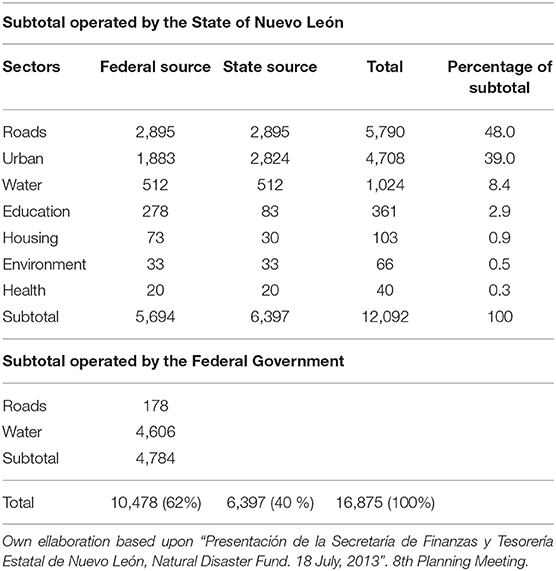
Table 4. Reconstruction expenditures, sources of finance and operation of funds, 2013 (millions of pesos).
Limitations and Shortcomings
There were also limitations and shortcomings in regard to the reconstruction work. In fact, at the moment of presenting the final report of the CERNL there several tasks were still pending completion. The incoming of Ingrid confirms the latter. Some of the works done in the reconstruction of Constitución and Mororones Prieto were not done entirely well. In several parts of these two arteries no storm drainage was introduced. The rains of Ingrid highlighted this problem and caused problems to transit and mobility. In the view of authorities there were no funds for this infrastructure (Aguilar-Barajas, 2013). Furthermore, in the context of the urgency to undertake the reconstruction work, some norms were not observed (Leal Diaz, 2012).
Although in its final report the CERNL mentioned that federal and state funds were assigned on time and in the agreed forms, it does not seem this was entirely the case. This is so true that one of the main recommendations of the report underlined the need to restructure the functioning of FONDEN and FONAREC (and their operating rules) as well as changes in the Public Works Law. As a matter of fact, 2 years after Alex, some of the damages were still unattended. The incoming of Hurricane Ingrid in September 2013, demonstrated the existence of deficient work in the main arteries Constitution and Morones Prieto. The press from those days illustrates this situation. Another example that things were not always well was the intention of the state government to substantially reduce its share in the total reconstruction budget, with hopes that the federal government would take a larger share. Once this was not accepted, there was also the intention to cover part of the state's share with funds from the 2011 federal budget proposal that did not pass either.
Without changing it entirely, the CERNL addressed relatively well the water governance framework existing before Alex. Even within this framework it was possible to secure inter and intra institutional collaboration at the three levels of government. It was mentioned earlier that metropolitan and flooding management in the MMA before Alex had very restrictive conditions. At the end of the Council work, the question was, “what is going to happen to this institutional capacity built for handling the reconstruction?” With the ending of the CERNL's mission, and in spite of the fact that the Council left a highly-detailed memoir of what to do in the future, in practice it seems that all this knowledge capital has been fading away. In part, due to the work of the Council, the state created the Nuevo León Council for Strategic Planning, charged with the responsibility to elaborate the State Development Plan. It is striking, though, that in these initiatives the issues of risk and flood management are given little attention.
It is also fair to say that while the CERNL contributed to the city's reconstruction after the occurrence of Alex, it lacked the structure to address underlying issues and structural matters associated with urbanization, like irregular human settlements along and on the river bed and the presence of climatic events. The complexity of these issues and their understanding go beyond actions designed in times of emergency.
Discussion
In large urban areas with high relevance to their national economies, such as the Monterrey Metropolitan Area, managing weather hazards, like flooding, should be seen as an issue of national interest. In this regard, robust water governance must be at the center of development policy design and implementation. As found by the OECD for the international arena, to a large extent water crises have to do with deficient governance frameworks (OECD, 2011). Therefore, thinking in terms of sustainability challenges for urban futures, which is the topic of this special issue of Frontiers in Environmental Science, the Monterrey story shows that investing in comprehensive, robust urban planning represents a good strategy to face climate change and variability.
The relatively effective reconstruction of the metropolis was possible thanks to the coordinated and collaborative work of a committed institution like the CERNL. In spite of the inherent difficulties the Council had to face—mostly due to the dispersion of the metropolitan and water governance—basic services were reestablished in a fairly rapid manner. This includes water, electricity, transport, and schools' infrastructures. After the summer holidays, students could return to school as if nothing had happened. Credibility in leadership was at the center of these achievements. It is fair to say that while the CERNL contributed to the city's reconstruction after the occurrence of Alex, it lacked the structure to address underlying issues and structural matters associated with urbanization and the occurrence of extreme climatic events. The complexity of these issues and their understanding go beyond actions designed in times of emergency.
The recognition of this complexity is clearly seen when one looks at the recommendations contained in the final report of the CERN, oriented to respond more effectively to the risks imposed by future hurricanes. Knowledge produced within the Council was presented in a systematic and ordered fashion in its final report. The main takeaways in terms of recommendations for increasing resilience to floods consisted in: building an additional regulating dam in the upper Santa Catarina River Basin to complement the existing Rompe Picos Dam system (arguably, two or more additional dams would be of use); relocating people living in areas at risk of flooding and impeding their return (i.e., to enforce existing federal land use laws); reforming and simplifying existing regulations on the operations of FONDEN as well as procedures for public works contracts (i.e., to cut red tape); reforestation of the upper basin of the Santa Catarina River to limit runoff downstream and into the city.
The MMA Water Fund (FAMM in Spanish), created in 2013 for that specific purpose, gathered stakeholders from government, the private sector, academia, and civil society in general. The Fund has been working systematically on this issue. In 2016, it purchased 1,200 hectares of land for reforestation in the upper basin. In 2018, FAMM was in the process of acquiring an additional 1,000 hectares. The message behind these initiatives is that society can organize itself around a common purpose. The connection of FAMM and the construction of capacities in the urban water sector is highly relevant.
Conclusions and Recommendations
The Monterrey Metropolitan Area is one of the economic hubs of Mexico and prone to flash flood hazards, which means the attention to this phenomenon is a matter of national interest. Over the decades the metropolis has been increasing its resilience to the presence of hurricanes, through the joint deployment of hard and soft infrastructure. Among the former the flood control Rompepicos Dam and the storm drainage program, undertaken in the 2000s in the aftermath of Hurricane Gilbert (1988), are cases in point. Concerning soft infrastructure, the (nationwide) establishment of early warning systems is a good example. The creation of FONDEN and FONAREC also aided in the institutional architecture to face flood hazards.
When Hurricane Alex hit in early July 2010, the city was more prepared due to projects carried out by the state government with the support of the federal government and the local community, despite the fact that the Santa Catarina River reached its second highest recorded flow. The fatalities caused by Alex were estimated at 15. The damages to the state of Nuevo León and the metropolis were, however, considerable. Furthermore, Alex revealed deficiencies in the existing framework for flood management.
In order to face the reconstruction of the state and the metropolis, the State Council for the Reconstruction of Nuevo León was established almost immediately. The Council did a fairly good job in getting things back to normal in a relatively short period of time. As highlighted in this case study, the service of piped water was reestablished for 85% of the population within the 3 days following the hurricane. Schools could start their new academic year in August, without much difficulty. Moreover, the reconstruction allowed for the replacement of strategic (but old) infrastructure, like the arteries Constitución and Morones Prieto, and several bridges, with much improved or new ones. This more robust infrastructure was tested in 2013 when Hurricane Ingrid hit the metropolis.
This relatively successful reconstruction shows the multi-faceted, collaborative work of the Council, which was the result of an enabling local environment. The Council was able to group and guide the efforts of the three levels of government and those from the civil society. The role of the private sector was essential in the coordination of the more than 5,000 actions documented in the final report. This public-private cooperation has a long-standing tradition in the state and the city and is rather rare in Mexico. Furthermore, this success is even more striking given the fragmented and dysfunctional water and metropolitan governance existing in the country. This is one of the major lessons of this case study.
Of course, there were limitations and shortcomings in the reconstruction process. The above restrictive framework meant time had to be invested in creating the necessary collaborative networks. Access to the funds of FONDEN and FONAREC could have been faster. Attention to the social agenda was limited. Handling land use regulations was beyond the sphere of influence. With the urgency, some of the works along Consitución and Morones Prieto arteries were not done well.
Several policy recommendations derive from this case study. For a hurricane prone region like the MMA, the incorporation of coherent urban planning should be a permanent, central part of local and national development policy. As shown, the losses associated with Alex had to do more with insufficient urban planning than with the phenomenon itself. More particularly, the incorporation of hydrological criteria and sound land use planning into urban development plans—and its corresponding legislation—are urgent matters.
Overall, the case of Alex indicates the need to professionalize the management of weather hazards. The Council gained and accumulated valuable knowledge that could be of use in the creation of a more permanent institution, whose work banks upon more proactive approaches and less on emergency-based responses. This new entity would need to have the capacities to draft a long-term plan for the metropolis. This proposal is a must in times when, paradoxically, the awareness and influence of the Council has been fading. Since July 2013, when the Council ended its mission, the interest and actions toward a comprehensive, preventive model has been diminishing. The lesson here is that the social construction of all this knowledge to increase urban resilience might be lost. Going back to the “business as usual” philosophy (Shaw, 2005), and waiting until the next hurricane comes, is not a sound strategy, especially under the current challenges imposed by climate change. In this more coherent approach, the focus on robust urban planning is a must.
More specifically, there is also the need to develop and use robust methodologies for valuing the impacts and adverse effects of future hurricanes. In turn, this requires the formation of human resources highly specialized in these matters. Although it did not get the level of other projects in the city and the country, the faults detected in the reconstruction of Constitución and Morones Prieto avenues revealed by hurricane Ingrid in 2013, show the fundamental importance of the initial design of infrastructure projects, which includes the professionalization of both the monitoring of projects and the budgeting process. This professionalization should also include the technical analysis of hydro meteorological risks and the proper communication of weather hazards like flooding. All these requirements suggest the need to strengthen the university curricula concerning disaster risk management. The media should also be included in this better equipped understanding of these issues.
In the end, it may be fair to hope that the lessons and experiences drawn from the case of Monterrey may also be of interest to other cities in Mexico and Latin American (Torregrosa et al., 2015). This case study shows that for metropolis like Monterrey, tackling the impacts of a hurricane like Alex, requires the collective production of knowledge and well-informed decisions about risk. The costs and benefits of risk taking in the light of development policy in general and flooding in particular have been the theme of serious research in the international sphere (WMO, 2009; UNESCO, 2012; World Bank, 2013). A useful warning for Monterrey, derived from the review of international literature (Frantzeskaki and Kabisch, 2016; Muñoz-Erickson et al., 2017), is that knowledge systems are dynamic—they do not last forever. The fading institutional capabilities and learning gained by the CERN, should be taken as reminder of the crucial necessity of sustaining and improving these capabilities. Doing this would be an indispensable input for a more preventive strategy. The next hurricane could well be around the corner.
Data Availability Statement
The raw data supporting the conclusions of this manuscript will be made available by the authors, without undue reservation, to any qualified researcher.
Author Contributions
IA-B: general coordination, economic impacts section, figures, photograph selection and editing, and editorial work. AR: hydrologic and hydraulic concepts, figures, photograph selection and editing, and editorial work.
Conflict of Interest
The authors declare that the research was conducted in the absence of any commercial or financial relationships that could be construed as a potential conflict of interest.
Acknowledgments
We are grateful to Mexico's National Council for Science and Technology (Conacyt-FORDECYT/12SE/2018/11/29-05) for financial support.
Footnotes
1. ^The recognition of the significance of these two avenues was presented during the working session of the CERNL, 2 years after Alex, which took place on the 5th of July, 2012. This information was obtained from the Council web site.
2. ^See press communique No. 26, of 18 July 2013. The following figures come from this document. In this meeting was presented the Memoir 2010–2013 with which the Council concluded formally its work.
3. ^Although out of this total, MX1400 million pesos were provided by the FONAREC, which means that the share of the state government is lower.
4. ^The source of thee data is: Secretaría de Finanzas y Tesorería General del Estado, Fondo de Desastres Naturales, Presentation of 18 July, 2013, internal document, available then on the webpage of the Council.
References
Aguilar Barajas, I., Sisto, N. P., and Ramírez, A. (2016). Water Governance in Mexico: an overview and the case of the Monterrey Metropolitan Area. Multi-level Governance in the Urban Context. IGLUS Quaterly. Innov. Govern. Large Urban Syst. 2, 2–7.
Aguilar-Barajas, I. (2013). Gestión de riesgos hidrometeorológicos extremos para el Área Metropolitana de Monterrey y su adaptación al cambio climático. Unpublished Final Report. Proyecto Fortalecimiento de la gobernanza hídrica en contextos de cambio climático: el caso dela Zona Metropolitana de Monterrey.
Aguilar-Barajas, I., Sisto, N. P., and Ramírez-Orozco, A. I. (2015). Agua Para Monterrey - Logros, Retos y Oportunidades Para Nuevo León y México. Monterrey: Agencia Promotora de Publicaciones S.A. de C.V. for Tecnológico de Monterrey; Centro del Agua para América Latina y el Caribe; Servicios de Agua y Drenaje de Monterrey.
Benavides, H., and Lozano, J. D. L. (2013). Huracán Gilberto 25 Años Después. Voces y Protagonistas (Hurricane Gilbert 25 Years After). Voices and Leading Actors. Monterrey: Mutimedios, Grupo Milenio.
Bitrán, D. (2001). Características del Impacto Socioeconómico de los Principales Desastres Ocurridos en México en el Período 1980-99. Serie. Impacto socioeconómico de los desastres en México. Mexico City: Secretaria de Gobernación; Centro Nacional de Prevención de Desastres.
Bourne, L. S., and Simmons, J. W. (1978). Systems of Cities: Readings on Structure, Growth and Policiy. New York, NY: Oxford University Press.
Cenapred (2006). Características e Impacto Socioeconómico de los Principales Desastres Ocurridos en la República Mexicana en el año 2005. Serie Impacto Socioeconómico de los Desastres en México. Mexico City: Secretaría de Gobernación.
CERNL (2013). Juntos Reconstruyendo Nuevo León. Memorias del Consejo Estatal para la Reconstrucción de Nuevo León. Monterrey: Gobierno de la República and Gobierno del Estado de Nuevo León, Unpublished Document.
Chávez Gutiérrez, J. (1995). “El sistema hidráulico,” in Atlas de Monterrey, ed G. Garza Villarreal (Monterrey; San Nicolás de los Garza; Mexico City: Gobierno del Estado de Nuevo León; UANL; INSEUR; COLMEX), 215–222.
CONAGUA (2018). Banco de Datos de Aguas Superficiales. Comisión Nacional del Agua. Available online at: http://app.conagua.gob.mx/bandas/ (accessed June 29, 2018).
de León Gómez, H. (2009). Peligros y Riesgos Naturales. Desarrollo Urbano de la Ciudad de Monterrey. Rizoma. Revista de Cultura Urbana, 32–34.
EGAP (2010). Lecciones del Huracán “Alex”. Monterrey: Tecnológico de Monterrey; Escuela de Administración Pública y Política Pública.
Frantzeskaki, N., and Kabisch, N. (2016). Designing a knowledge co-production operating space for urban environmental governance – Lessons from Rotterdam, Netherlands and Berlin, Germany. Environ. Sci. Policy 62, 90–98. doi: 10.1016/j.envsci.2016.01.010
Friedman, J. (2002). The Prospect of Cities. Minneapolis, MN; London: The University of Minnesota Press.
Gobierno Constitucional del Estado de Nuevo León (2010a). Plan Estatal de Desarrollo 2010-2015. Monterrey: Gobierno del Estado.
Gobierno Constitucional del Estado de Nuevo León (2010b). Atlas de Riesgo para el Estado de Nuevo León (Primera Etapa) (Documento de Consulta Pública). Monterrey: Gobierno del Estado, Secretaría de Desarrollo Sustentable.
Graham, C. G. R. (1911). “The water-works and sewerage of Monterrey,” in Vol. LXXII, Transactions of the American Society of Civil Engineers, Paper No. 1193 (Monterrey).
Hallegatte, S., Rentschler, J., and Walsh, B. (2018). Building Back Better: Achieving Resilience Through Stronger, Faster, and More Inclusive Post-Disaster Reconstruction. Washington, DC: World Bank. Available online at: https://openknowledge.worldbank.org/handle/10986/29867
Leal Diaz, J. (2012). Mitos y Realidades del Agua en Monterrey. Monterrey: Permacultura. Available online at: www.permacultura.org.mx/dropbox/Lel-Diaz_2012-Agua.pdf (accessed August 3, 2018).
Magaña, V., Tejeda, A., and Vázquez, G. (2014). El Sistema de Alerta Temprana ante ciclones tropicales desde una perspectiva de riesgo. Revista H2O Gestión del Agua. 50–55.
Meerow, S., Newell, J. P., and Stultss, M. (2016). Defining urban resilience: a review. Landsc. Urban Plann. 147, 38–49. doi: 10.1016/j.landurbplan.2015.11.011
Miller, T. R., Chester, M., and Muñoz-Erickson, T. (2018). Rethinking infrastructure in an era of unprecedented weather events. Issues Sci. Technol. 34.
Muñoz-Erickson, T., Miller, C. A., and Miller, T. R. (2017). How cities think: knowledge co-production for urban sustainability and resilience. Forests 8:203. doi: 10.3390/f8060203
OECD (2011). Water Governance in OECD Countries: A Multi-Level Approach. Paris: Organisation for Economic Cooperation and Development.
OECD (2013a). Water and Climate Change Adaptation: Policies to Navigate Uncharted Waters. OECD Studies on Water. Paris: OECD Publishing.
OECD (2013b). OECD Reviews of Risk Management Policies: Mexico 2013: Review of the Mexican National Civil Protection System. Paris: OECD Publishing. doi: 10.1787/9789264192294-en
OECD (2013c). Making Water Reform Happen in Mexico. Assessment and Recommendation. Paris: OECD Publishing. doi: 10.1787/9789264187894-en
Pant, R., Thacker, S., Alderson, J. W., and Barr, S. (2018). Critical infrastructure impact assessment due to flood exposure. J. Flood Risk Manage. 11, 22–33. doi: 10.1111/jfr3.12288
Ramírez, A. (2011). Evaluación del Funcionamiento de la Presa Rompepicos. Proyecto Reconstrucción del Río Santa Catarina después de los impactos del huracán Alex. Monterrey: ITESM; CONAGUA.
SADM (2010a). Tormenta Tropical Alex.- El agua, Prioridad Inmediata, Monterrey: Servicios de Agua y Drenaje de Monterrey; Gobierno del Estado de Nuevo León.
Salazar, H. (2008). “La metrópoli del tercer milenio. Un vistazo al futuro de Monterrey,” in La Enciclopedia de Monterrey, Tomo. III, Nuevo León: Visión al Futuro, ed I. Cavazos Garza (Monterrey: Agencia Promotora de Publicaciones, 381–426.
Schmidt, S., and Hatch Kuri, G. (2012). El agua en México. Una cuestión de seguridad nacional. Foreign Affairs Latinoamérica. 12, 89–96.
Shaw, W. D. (2005). Water Resource Economics and Policy: An Introduction. Cheltenham; Northampton: Edward Elgar Pub.
Sisto, N. P., Ramírez, A., Aguilar Barajas, I., and Magaña Rueda, V. (2016). Climate threats, water supply vulnerability and the risk of a water crisis in the Monterrey Metropolitan Area (Northeastern Mexico). Phys. Chem. Earth. 91, 2–9. doi: 10.1016/j.pce.2015.08.015
Sisto, N. P., and Ramírez-Orozco, A. I. (2015). “Chapter 9: Flash floods in the Monterrey Metropolitan Area, Mexico.- Lessons from Hurricane Alex,” in Water and Cities in Latin America: Challenges for Sustainable Development, eds I. Aguilar-Barajas, J. Mahlknecht, J. Kaledin, M. Kjellén, A. Mejía-Betancourt (Abingdon: Routledge), 149–164.
Torregrosa, M. L., Aguilar-Barajas, I., Jiménez-Cisneros, B., Kloster, K., Martínez, P., Palerm, J., et al. (2015). Urban water in Mexico in IANAS and UNESCO (Coord.), Urban Water. Challenges in the Americas. A Perspective from the Academies of Sciences, Mexico City and Paris, Inter American Network of Academies of Sciences and United Nations Educational, Scientific and Cultural Organization, pp. 382–413.
Torres, E., and Santoscoy, M. A. (1985). La historia del agua en Monterrey: desde 1577 hasta 1985. Ediciones Castillo. Monterrey, Nuevo León, México.
UN (2011). GAR 2011. Global Assessment Report on Disaster Risk Reduction. Revealing Risk, Redefining Development. New York, NY: United Nations Office for Disaster Risk Reduction.
UNESCO (2012). Managing Water under Uncertainty and Risk. The United Nations World Water Development Report 4. Executive Summary. Paris: United Nations Educational, Scientific and Cultural Organization.
UNISDR (2017). United Nations Office for Disaster Risk Reduction. Annual Report 2016. United Nations.
World Bank (2013). World Development Report 2014: Risk and Opportunity – Managing Risk for Development. Washington, DC: The World Bank. doi: 10.1596/978-0-8213-9903-3
World Economic Forum (WEF) (2019). The Global Risks Report 2018. 13th Edition. Geneva: World Economic Forum. Available online at: http://www3.weforum.org/docs/WEF_Global_Risks_Report_2019.pdf (accessed March 10, 2019).
Keywords: urban resilience, floods, Monterrey, Mexico, infrastructure, reconstruction council
Citation: Aguilar-Barajas I and Ramirez AI (2019) Recovering of the Monterrey Metropolitan Area, Mexico, After Hurricane Alex (2010): The Role of the Nuevo Leon State Reconstruction Council. Front. Environ. Sci. 7:163. doi: 10.3389/fenvs.2019.00163
Received: 20 May 2019; Accepted: 01 October 2019;
Published: 05 November 2019.
Edited by:
Hallie Eakin, Arizona State University, United StatesReviewed by:
Chung Shing Chan, The Chinese University of Hong Kong, ChinaRoberta Cucca, Norwegian University of Life Sciences, Norway
Copyright © 2019 Aguilar-Barajas and Ramirez. This is an open-access article distributed under the terms of the Creative Commons Attribution License (CC BY). The use, distribution or reproduction in other forums is permitted, provided the original author(s) and the copyright owner(s) are credited and that the original publication in this journal is cited, in accordance with accepted academic practice. No use, distribution or reproduction is permitted which does not comply with these terms.
*Correspondence: Ismael Aguilar-Barajas, aWFndWlsYXJAdGVjLm14
 Ismael Aguilar-Barajas
Ismael Aguilar-Barajas Aldo I. Ramirez
Aldo I. Ramirez